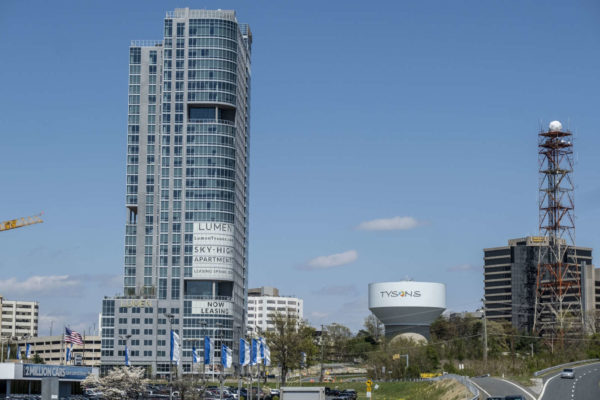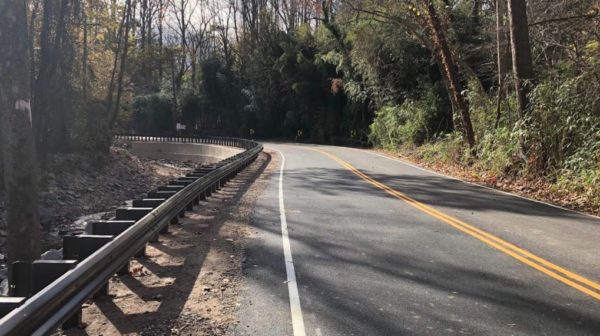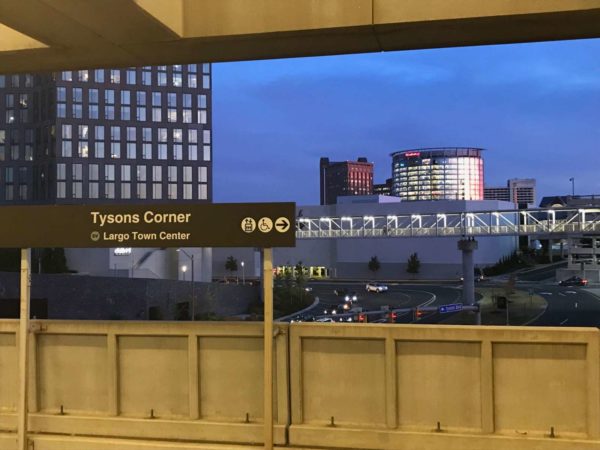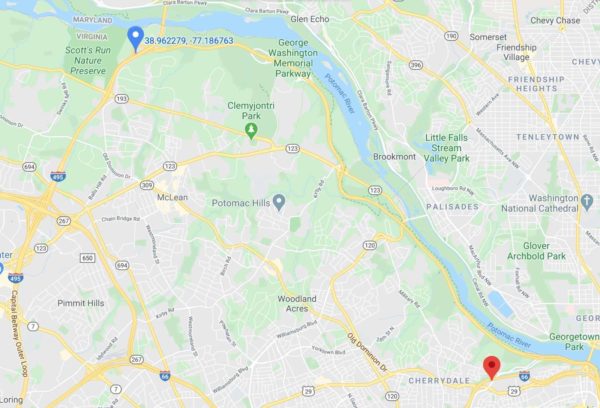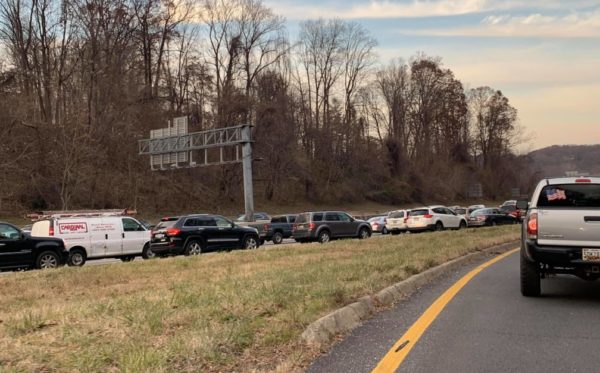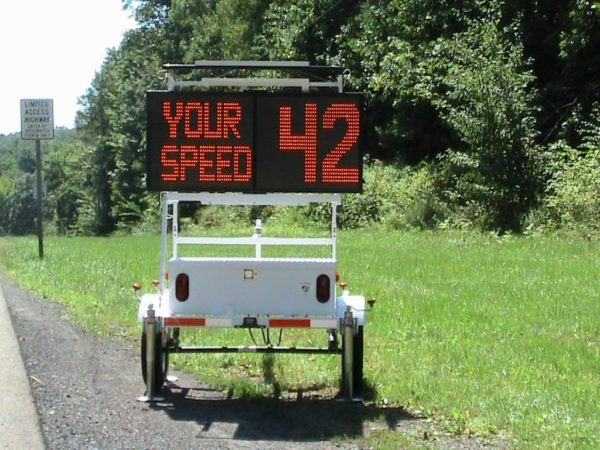Gov. Northam Makes Testing Work Group — “The group will “make sure all of Virginia’s public and private testing efforts are coordinated and pulling in the same direction,” Northam said during a Monday press conference.” [Inside NoVa]
Local Student Looks to Celebrate the Class of 2020 — “After Loudoun County seniors Arianna Wright and Aiden Bullis came up with the idea to sell class of 2020 signs and distributed 1,000, Abby Diamond wanted the same concept in Fairfax County. The Madison High School senior has started to sell signs reading ‘Class of 2020 senior #allinthistogether’ in support of the 2020 graduates. So far, she’s sold about 100 and has reached various high schools.” [Patch]
ICYMI: Foust’s Budget Meeting is Tonight — “Foust is set to talk to Fairfax County Chief Financial Officer Joe Mondoro about the budget, and answer people’s questions, according to his recent newsletter to constituents. The town hall is set to start at 7 p.m. [on Tuesday.]” [Tysons Reporter]
Distance Learning Challenges Plague FCPS — “School officials say that updates made by Blackboard over the weekend have not corrected delays with the system… The Fairfax County School Board is expected to receive an update on the rollout of distance learning on Thursday (April 23).” [Reston Now]
APRIL 20: COVID-19 Update for Fairfax County Fire and Rescue Personnel. #FCFRD continues to fully staff all stations and apparatus. More: https://t.co/1FyydVv0Po #FFXCOVID #FairfaxCounty pic.twitter.com/2KUCjRmAgD
— Fairfax Fire/Rescue (@ffxfirerescue) April 20, 2020
Dranesville District Supervisor John Foust plans to host a virtual town hall tomorrow (Tuesday) to discuss the revised budget proposal for Fairfax County.
Fairfax County staff revisited the proposed budget for fiscal year 2021 and made changes to address the economic uncertainty and upheaval caused by the coronavirus pandemic.
Now, Foust is set to talk to Fairfax County Chief Financial Officer Joe Mondoro about the budget, and answer people’s questions, according to his recent newsletter to constituents.
The town hall is set to start at 7 p.m. tomorrow and will last until 8:30 p.m.
People can can submit questions by calling 703-324-1114, post them in a comment under the Facebook Live event or email them in advance to [email protected] and include “Dranesville District Budget Town Hall” in the subject line.
The town hall will also be shown on Channel 16 and be streamed online.
Kirby Road in McLean will be closed for much of next week for a culvert replacement.
That the road closure of Kirby Road at Claiborne Drive is expected to last from Tuesday (April 21) to Friday (April 24), according to the Virginia Department of Transportation.
In a letter to constituents, Dranesville District Supervisor John Foust said that work to repair flooding damage to Kirby Road last summer led to the discovery of a failed pipe.
More from Foust’s letter:
The work will be done during the week as daily traffic levels are significantly reduced due to the coronavirus pandemic and stay-at-home order. In addition to electronic notices, variable message boards will be installed at the intersections of Route 123 and Kirby Road and Old Dominion Drive and Kirby Road this week to inform drivers of the upcoming closure.
Following the massive July 8 storm event that occurred last year, an extensive emergency repair project was completed to reopen Kirby Road, which had been significantly impacted. While that work was underway, the failure of the pipe that will be replaced during this effort was discovered.
It was determined that additional survey, utilities research, easement acquisition, plan design, and construction would be needed and that the work would take until early 2020 to complete, which was well after Kirby Road was planned to reopen to traffic.
Thus, VDOT decided to substantially complete the Kirby Road emergency project and was able to reopen the road in December 2019. Since then, necessary survey and utilities investigation was completed, access rights were acquired, design plans for the culvert were developed, and materials were acquired to prepare for work to begin next week.
People will still be able to access properties along Kirby Road. “However, traffic will not be able to go beyond the point of pipe replacement in either direction,” according to VDOT.
Photo via VDOT/Twitter
Welcome back from the long weekend! Here are the latest stories about the Tysons area that the Tysons Reporter team has been reading:
McLean Rep Lauds Environmental, Housing Efforts —“Buoyed by his party’s sweeping victories locally and statewide last fall and the infusion of new blood on the Fairfax County Board of Supervisors, Supervisor John Foust (D) was upbeat about a host of initiatives Feb. 20 during his annual “State of McLean” speech to the Greater McLean Chamber of Commerce.” [Inside NoVa]
Falls Church Officials Face $1.207 Million City Hall Overrun — “City Manager Wyatt Shields said the cost can be absorbed by the surplus the City built up in the current fiscal year by delaying a first payment on the bond for the new high school and otherwise favorable (low interest rate) economic conditions.” [Falls Church News-Press]
Woes About Broad-Washington Project — “Public access to the parking lot, a surface lot sitting directly behind Thompson Italian, Clare and Don’s and adjacent the State Theatre, is considered by those businesses among their most critical assets for attracting the customers they need to succeed.” [Falls Church News-Press]
Vienna Business Leaders Talk Advocacy — “Vienna’s business owners galvanized and spoke out last July when the Council briefly flirted with rescinding an approved mixed-use rezoning at 374-380 Maple Ave., W. Business people who spoke at the six-hour-long meeting that began July 15 offered a perspective that wasn’t being heard, said Bollettino, adding it was fortunate the Council did not move forward with the proposal.” [Inside NoVa]
Fairfax County’s Board of Supervisors is supporting an application for federal funding to pay for a rehabilitation project along the GW Parkway.
Dranesville District Supervisor John Foust proposed the board matter, which supports an application for funding from the Infrastructure for Rebuilding America grant program.
The funding would support the parkway’s North Section Rehabilitation Program, which aims to reconstruct nearly 8 miles of the GW Parkway from Spout Run Parkway to I-495.
“The proposed project addresses serious deterioration of the parkway and implements significant safety improvements,” the board matter says.
If the funding is approved, the board matter says the National Park Service (NPS) plans to:
- repave the road
- repair stormwater management systems and walls
- rehabilitate two historic, scenic overlooks
- replace guardrails
- construct new curbs
- build emergency turnarounds along the north end
The project will also include work on a northern section, addressing a $1.7 billion maintenance backlog that includes $395 million for the parkway, the board matter says.
More than 33 million vehicles per year travel on the GW Parkway, according to Fairfax County. Last year, emergency work had to fix the cause of a sizable sinkhole on the GW Parkway, disrupting traffic for months in the area.
Foust noted that the project is meant to address safety and longevity issues for the parkway.
The Board of Supervisors voted to approve sending a letter of support for NPS’s application for the federal funding.
Map via Google Maps
Dranesville District Supervisor John Foust said he’s supportive of plans to extend the express lanes on I-495, but has major concerns about the timing of the project with Maryland’s piece.
The I-495 Northern Extension Project would expand express lanes from the Dulles Toll Road to the George Washington Memorial Parkway, replace overpasses and noise walls and add a shared-use path. The project could save drivers up to 25 minutes during peak-hour commute times, according to the presentation given at the meeting.
Toll revenues are expected to support the cost of the project, according to the presentation.
Maryland is currently evaluating its options to rebuild and widen the American Legion Bridge, Susan Shaw, from the Virginia Department of Transportation, told the Fairfax County Board of Supervisors.
Preliminarily, construction could start on Virginia’s portion of the project in 2021 and take three years to finish, Shaw said.
“Obviously, solving the congestion issues at the American Legion bridge are just absolutely essential that we do that,” Foust said at the Transportation Committee meeting on Tuesday. “This project doesn’t solve the congestion problems.”
While Foust said that the project is a “necessary piece of the puzzle that will do that,” he said that most of the relief will come from increasing capacity and widening the Beltway from Maryland.
Foust said he thinks it would be a “huge mistake” to start the Virginia part of the project before it can get aligned with Maryland’s timeframe.
“Timing is everything here,” Foust said. “You’ve got to get this coordinated better with what they’re doing in Maryland or a bad situation is going to get worse.”
A public meeting on the project is set for March 12 at Langley High School (6520 Georgetown Pike) from 6:30 to 8:30 p.m. Public comments will be accepted through March 30, although Shaw said the public can reach out anytime after that.
“You want to extend the express lanes, but that’s not a good enough public purpose reason for doing this,” Foust said.
In a newsletter to constituents today, Dranesville District Supervisor John Foust said a meeting in March will solicit community input on the American Legion Bridge.
Currently, the 495 Express Lanes Northern Extension project — a.k.a. 495 NEXT — would extend the 495 Express Lanes north from the I-495 and Dulles Access Road interchange up to the American Legion Bridge and add two new tolled express lanes in each direction.
The Virginia Department of Transportation (VDOT) is set to present the results of the 495 NEXT environmental study and traffic analysis on Thursday, March 12.
Foust’s newsletter said that “one of the biggest transportation challenges in the McLean area is the congestion caused by inadequate capacity on the American Legion Bridge and the Maryland side of the Beltway.”
More from the newsletter:
In early 2019, VDOT signed a nonbinding Development Framework Agreement with Transurban. Delivering the project through this public private partnership would mean that no public funding by the Commonwealth is needed to extend the Express Lanes network. If approved, the project will replace Live Oak Drive, Georgetown Pike, and Old Dominion Drive Bridges and allow for the installation of pedestrian/bike facilities along the corridor. Construction could begin as early as 2021.
Virginia officials have been cautious about moving forward with the project because without replacing the American Legion Bridge, bottlenecks and congestion will only be relocated, not resolved.
A major development occurred late last year when Virginia Governor Northam and Maryland Governor Hogan announced “The Capital Beltway Accord.” The agreement is a commitment to work together to create a new, unified Capital Beltway and replace the aging American Legion Bridge. The cost of the bridge project is expected to be $1 billion and both states will contribute to the cost through public-private partnerships. The private entity will pay the upfront costs in exchange for future toll revenue meaning toll payers rather than taxpayers will foot the bill.
The new bridge will have four express toll lanes, in addition to eight free lanes, as on the current span. The tolls will fluctuate based on congestion, rising to keep traffic flowing freely. Construction could begin in 2022 and would likely take five or six years.
The next key piece of the puzzle is ensuring that the widening of I-495 just over the bridge in Maryland is done in coordination with the bridge project. Governor Hogan recently obtained a key vote to advance a plan to widen the Beltway from the American Legion Bridge to the Interstate 270 spur, and along the lower part of I-270 between the Beltway and Interstate 370.
“I am excited that we are making progress on addressing congestion issues that have plagued our communities, but I want to be sure that the project is done in a way that actually addresses our problems, rather than just moving them,” Foust said in the newsletter.
At the March 12 meeting, attendees will be able to provide input during a public hearing.
The meeting is set to run from 6:30-8:30 p.m. at Langley High School in McLean (6520 Georgetown Pike).
The Fairfax County supervisors representing Tysons and McLean voiced support for a proposed change that would allow residents to access roads with restricted turns during peak-hours.
Currently, a joint program from the transportation departments for Virginia and Fairfax County restricts access to neighborhood roads during peak-hour traffic — including the residents.
Fairfax County has three cut-thru restrictions in place. Four additional ones are at various stages, including:
- Dead Run Drive/Carper Street in McLean
- Electric Avenue/Williams Avenue/Overlook Street in the Tysons area
- Allen Avenue in the Falls Church area
Earlier this year, Virginia General Assembly passed a law allowing local jurisdictions to create a program to issue permits or stickers to residents to make turns into or out of a designated area during certain times of the day when those turns are not allowed.
Now, Fairfax County is considering creating the program with permits.
“Permits would not be available for visitors, caregivers, service providers, non-resident owners, relatives, or other non-residents,” according to a presentation to the Board of Supervisors today (Tuesday).
The Fairfax County Department of Transportation has submitted a budget request for fiscal year 2021 to pay for the change.
“We have not received any funding to pay for this,” Henri Stein McCartney, a transportation planner for FCDOT, told the board.
While the supervisors mostly agreed that cut-thru traffic is — as Lee District Supervisor Jeff McKay called it — a “bad problem” made worse by navigation software like Waze, they disagreed on whether or not to pursue the proposed change.
Chairman Sharon Bulova said that she is worried about not allowing people who need to get to the homes in the cut-thru area but aren’t residents.
Mason District Supervisor Penny Gross echoed Bulova’s concerns, saying that the program would create an “equity problem.”
“I don’t see anything that is broken here that needs to be fixed,” Gross said.
Gross also said that she does not support the “enormous” cost of the $230,000 software needed for the change.
Dranesville District Supervisor John Foust argued that residents should have access to the cut-thru areas, saying that the proposed change would allow more people in instead of keep more people out of the areas.
“Not being able to turn into your own neighborhood is what keeps neighborhoods from doing [the cut-thru program],” Providence District Supervisor Linda Smyth said. “We need to have some sort of selectivity here.”
Other supervisors, like McKay, voiced indecision on the proposal.
FCDOT now plans to work on a draft ordinance for a Board of Supervisors public hearing.
Photo via Facebook
Come January, the Fairfax County Board of Supervisors is set to see four new faces — and all of them are Democrats.
Democrat Dalia Palchik defeated her Republican opponent for the Providence District seat, which represents Tysons and Merrifield.
In addition to Palchik, new faces on the 10-member board will include Democrats James Walkinshaw for the Braddock District, Walter Alcorn for the Hunter Mill District and Rodney Lusk for the Lee District, according to unofficial election results.
Voters reelected Dranesville District Supervisor John Foust, along with Penny Gross (Mason District), Daniel Storck (Mount Vernon), Kathy Smith (Sully) and Pat Herrity (Springfield).
With Republican John Cook, who represents the Braddock District, retiring, Herrity will be the only Republican on the board.
Current Lee District Supervisor Jeff McKay won the board’s chair.
Absentee votes now counted and Pat Herrity (R) has hung on in Springfield District in Fairfax County- the last Republican standing on a new Board of Supervisors that will be 9-1 Democratic. School Board will now be 12-0 Democratic.
— Ben Tribbett (@notlarrysabato) November 6, 2019
In a celebratory newsletter thanking her supporters, Palchik wrote, “I am proud to be the first Latina to hold this position.”
Palchik, who currently who is the Providence District member on the Fairfax County School Board, ran on a platform focused on education funding and reducing greenhouse gas emissions.
In an interview with Tysons Reporter, Palchik said that she wants to tackle affordable housing — “the number one challenge… in the Tysons area” — and finding solutions to the last mile challenge.
“Big Win” for Democrats
Del. Kathleen Murphy (D-34) called yesterday’s election a “big win” for Democrats in Virginia. For the first time since 1993, Democrats took control of both the State Senate and the House of Delegates.
Murphy told attendees at a Democratic watch party last night to think about the “misery we felt” when former Rep. Barbara Comstock won the 10th congressional district.
“We never wanted to feel that way again,” Murphy. “So what did we do? We went out and we won.”
Virginia Democrats win majorities in both the state House and Senate, giving them control of the legislature and the governorship for the first time in 26 years. Follow our full U.S. election coverage. https://t.co/z2PXWC7DHk
— AP Politics (@AP_Politics) November 6, 2019
Voters Approve Funding for Public School Renovations
Fairfax County voters also OK’d a $360 million school bond referendum that includes $2 million in planning funds for a new “Silver Line elementary school,” along with:
- $19.5 million in construction funds for adding an addition to Madison High School in Vienna
- $49.6 million in construction funds for renovating Cooper Middle School in McLean
- $1.7 million in planning funds for renovating Louise Archer Elementary School in Vienna
Fairfax County uses bonds to pay for renovating and building new schools.
Kalina Newman contributed to this story.
Editor’s Note — Tysons Reporter is running Q&As with the candidates running for the Dranesville and Providence District seats on the Fairfax County Board of Supervisors this week. The stories have been lightly condensed and edited for clarity.
Featured here is Democrat John Foust, who is running against Republican Ed Martin for the Dranesville District seat, which represents McLean, Great Falls, Herndon and portions of Vienna and Falls Church.
John Foust is hoping that the upcoming election will land him another term representing people in McLean on the Board of Supervisors.
First elected to the board in 2007, Foust currently serves as the chairman of the county’s transportation and information technology committees, along with chairing the Fairfax County Economic Advisory Commission.
Originally from Johnstown, Pennsylvania, Foust has been living in Northern Virginia since 1981 and in McLean since 1987, according to his county bio. He’s worked in steel mills and practiced construction law in Northern Virginia.
During a recent candidate debate in McLean, Foust pointed to his experience on the county board — pointing to the expansion of Balls Hill Road at Georgetown Pike to address traffic and the widening of Leesburg Pike (Route 7).
Tysons Reporter met up with Foust in his office to ask about how he would tackle affordable housing and capacity issues at public schools and what his top infrastructure priorities are if he is re-elected for another four-year term.
Tysons Reporter: Do you any plans to encourage the use of wind and solar polar among constituents. If so, how?
John Foust: Definitely. We are particularly with solar we at the county level have 130 or so buildings that we are looking at putting solar on, but with the constituents we are going out to the community with the CECAP — a community-wide energy and climate action planning process — and part of that is going to be looking at the possibility of solar on residential and commercial buildings in Fairfax County.
TR: As people come into the area, what do you say are your top priorities to stay and age in place?
Foust: At the county level, we have a 50+ Committee that has developed a lot of programs and services to address the senior population and to help them stay in their homes. Locally, I have established three different groups — one in McLean, one in Great Falls and one in Herndon — to help seniors and people with disabilities stay in their homes and stay in the community.
Each one has taken is set up to be run by volunteers and community leaders, and each one has taken on a slightly different angle on how they are going to do that based on what they think the most immediate needs are in their particular community.
For example in Herndon, it’s almost exclusively designed around transportation and getting seniors rides to their doctors and to wherever they need to go. It’s the most common complaint we hear from seniors is that they don’t have transportation.
So then we have in Great Falls, which is a semi-rural community and people don’t see each other on a regular basis all of the time, they focus more on a social environment. In McLean, it has been very active. We’re focusing a lot on education and resources.
TR: Anything you haven’t done yet that you would want to do to help people age in place?
Foust: The most important thing we can do for some people is to get the economy going to the point where they have a strong economy that can provide tax relief. That’s a very expensive proposition but it’s also something that is contributing to the difficulties seniors have staying in their homes.
We — Fairfax County and all counties in Virginia — our primary funding source is property taxes and so there are programs available to provide relief to seniors but they are not very generous and they can’t be until we have other revenue sources to subsidize that relief.
TR: What about home-sharing?
Foust: We’ve talked about it on numerous occasions. There are obviously issues having strangers come into your home and being responsible for some of your care. So there are issues but there are nonprofits that I think take the issues on and make that happen. And it would be a very positive development if we had that. It would provide another choice.
TR: How do you want to approach affordable housing? What do you think the county can do to make sure there are enough units for young professionals coming in?
Foust: The market pretty much delivers the housing we need for the people earning 120% or more of the AMI — the area median income. We use inclusionary zoning to try to create a significant inventory of what we would call workforce housing, which is in the 80-120% of AMI in and around the Metro stations. But then for 80% or 60% of AMI or lower, it’s a huge challenge and that’s the affordable housing market that we as a government have to be more involved in, whether it’s creating incentives or financial participation.
At the Board of Supervisors, we dedicate half of a penny a year — this is a new development — on the real estate tax, which is about $12 million, to support nonprofits and others who are trying to preserve the affordable housing that we do have. And then we added an additional penny, which is about $25 million a year — to support nonprofits and others who are trying to expand to the number of affordable housing units that we have in the county.
We, as a board, we have made a commitment to have delivered 5,000 units of affordable housing for people earning 60% or lower of the AMI over the next 15 years.
TR: Do you think the county needs to do more for affordable housing? Or is the track you’re on right now —
Foust: — No, the track we’re on right now isn’t — it’s a much better track, but it’s not going to lead to fully satisfying the demand. So that’s why we have other tools that we use. And we have Phase 1 of the Strategic Plan identified 25 different things that we could be doing. For example, big things like working with nonprofits [and] making government-owned land available.
TR: What are your top three transit infrastructure priorities?
Foust: Completing the Silver Line is absolutely critical. Creating and expanding a bus rapid transit network between activity centers in the county. And expanding the general bus service feeding the Metro stations on the Silver Line.
TR: Overall, how do you think the county can better approach capacity issues at the public schools?
Foust: You have to look at adjacent school districts and see if there are dramatic capacity differences and if so, whether there is are adjacents that can be made with community support to utilize the capacity at schools that are underutilized and relieve the pressure on schools that are over capacity.
You also have the Capital Improvement [Program], which require significant funding. So we made significant increases in capital improvements for schools currently at $180 million a year under bonding authority. In all probability, that number should be higher and we need to continue to look at that and try to get more projects done.
And generally, other outside funding via bonding in other areas to deliver more annual funding streams to focus on capital improvements and renovating the schools and increasing capacity.
TR: I’m assuming it’s different trying to address it before it becomes an issue than have to go back and try to fix it.
Foust: Yeah. We just have to bite some bullets and build some new schools. Eventually, we have built very few new schools in the county in the past decade and [the] population continues to grow.
My sense is that the School Board feels that buying the land is not the best bang for the buck because they already have schools with the land and it makes more sense to expand those schools. And from an operating standpoint — budgetary — it makes more sense to renovate and expand the schools you have rather than to build new schools.
But that gets you so far and at some point, you’re going to need to get some new schools. The one in Tysons is very high on my priority for the elementary school, especially. They have the land proffered to us, given to us by a developer. And it just needs to be incorporated into the school’s CIP and built.


